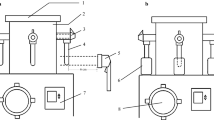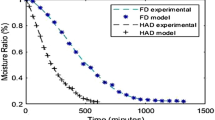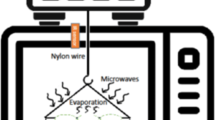Abstract
A method for reducing the energy consumption during freeze drying has been proposed. Water activity variation with time has been explored for button mushroom (Agaricus bisporus L.). The effect of primary and secondary drying temperatures on water activity was found significant (p < 0.05) as compared to sample thickness and pressure. The economics of the process showed that an energy reduction up to 34.9% could be achieved if the final water activity was constrained at 0.6. Artificial neural network tool has been used to develop a model for predicting the water activity precisely for a given combination of time, initial moisture content, vacuum pressure, sample thickness, and primary and secondary drying temperatures. The model-predicted values were found to be in good agreement (R = 0.97) with the experimental data. The model developed is expected to extend its aid in energy reduction for freeze drying of other food products.





Similar content being viewed by others
Abbreviations
- a w :
-
Water activity
- b ij , b ij * :
-
Network bias
- H I ij :
-
Hidden layer input
- H O ij :
-
Hidden layer output
- I i :
-
Input
- max(x):
-
Maximum value in x
- min(x):
-
Minimum value in x
- O O 1 :
-
Final output of the ANN infrastructure
- O I 1 :
-
Processed input signal to the output neuron
- T :
-
Set target for backpropagation (error control)
- v ij , w ij , X ij :
-
Connection weights
- x :
-
Data set
- x norm :
-
Normalized data set
References
Basheer, I. A., & Hajmeer, M. (2000). Artificial neural networks: fundamentals, computing, design, and application. Journal of Microbiological Methods, 43(1), 3–31. https://doi.org/10.1016/S0167-7012(00)00201-3.
Dorofki, M., Elshafie, A.H., Jaafar, O., Karim, O.A., Mastura, S. (2012). Comparison of Artificial Neural Network transfer functions abilities to simulate extreme runoff data. In: International conference on environment, energy and biotechnology, IACSIT press, Singapore. 33:39–44.
Fellows, P. (2000). Freeze drying and freeze concentration. In Food Processing Technology (2nd ed., pp. 441–451). England: Woodhead publications limited.
Ferreira, S. L. C., Bruns, R. E., Ferreira, H. S., Matos, G. D., David, J. M., Brandao, G. C., Silva, E. G. P., Portugal, L. A., Reis, P. S., Souza, A. S., & Santos, W. N. L. (2007). Box-Behnken design: an alternative for the optimization of analytical methods. Analytica Chimica Acta, 597(2), 179–186. https://doi.org/10.1016/j.aca.2007.07.011.
Franks, F. (1998). Freeze-drying of bioproducts: putting principles into practice. European Journal of Pharmaceutics and Biopharmaceutics, 45(3), 221–229. https://doi.org/10.1016/S0939-6411(98)00004-6.
Karimi, F., Rafiee, S., & Garavand, A. T. (2012). Optimization of an air drying process for Artemisia absinthium leaves using response surface and artificial neural network models. Journal of the Taiwan Institute of Chemical Engineers, 43(1), 29–39. https://doi.org/10.1016/j.jtice.2011.04.005.
Khalloufi, S., Giasson, J., & Ratti, C. (2000). Water activity of freeze dried mushrooms and berries. Canadian Agricultural Engineering, 42(1), 51–56.
Labuza, T. P. (1980). The effect of water activity on reaction kinetics of food deterioration. Food Technology, 36–41.
Menlik, T., Kirmaci, V., & Usta, H. (2009). Modeling of freeze drying behavior of strawberries by using artificial neural network. Journal of Thermal Science and Technology, 29(2), 11–21.
Menlik, T., Kirmaci, V., & Usta, H. (2010). Determination of freeze-drying behaviours of apples using artificial neural network. Expert Systems with Applications, 37(12), 7669–7677. https://doi.org/10.1016/j.eswa.2010.04.075.
Patel, S. M., Doen, T., & Pikal, M. J. (2010). Determination of end point of primary drying in freeze-drying process control. AAPS Pharmaceutical Science and Technology, 11(1), 73–84. https://doi.org/10.1208/s12249-009-9362-7.
Pikal, M. J., Cardon, S., Bhugra, C., Jameel, F., Rambhatla, S., Mascarenhas, W. J., & Akay, H. U. (2005). The non-steady state modeling of freeze drying: In-process product temperature and moisture content mapping and pharmaceutical product quality applications. Pharmaceutical Development and Technology, (1), 17–32. https://doi.org/10.1081/PDT-35869.
Ratti, C. (2001). Hot air and freeze-drying of high-value foods: a review. Journal of Food Engineering, 49(4), 311–319. https://doi.org/10.1016/S0260-8774(00)00228-4.
Tarafdar, A., Shahi, N. C., Singh, A., & Sirohi, R. (2017). Optimization of freeze-drying process parameters for qualitative evaluation of button mushroom (Agaricus bisporus) using Response Surface Methodology. Journal of Food Quality. https://doi.org/10.1155/2017/5043612.
Acknowledgements
The authors express their heartfelt gratitude to the Mushroom Research Center (MRC), G.B. Pant University of Agriculture and Technology, Pantnagar, Uttarakhand, India, for cultivating button mushrooms in their facility and making them available for this work. The authors extend their thanks to Dr. U.C. Lohani, Er. Anurag Kushwaha, and Er. Ashish Kumar for providing their valuable assistance for successful completion of this work.
Author information
Authors and Affiliations
Corresponding author
Rights and permissions
About this article
Cite this article
Tarafdar, A., Shahi, N.C., Singh, A. et al. Artificial Neural Network Modeling of Water Activity: a Low Energy Approach to Freeze Drying. Food Bioprocess Technol 11, 164–171 (2018). https://doi.org/10.1007/s11947-017-2002-4
Received:
Accepted:
Published:
Issue Date:
DOI: https://doi.org/10.1007/s11947-017-2002-4




